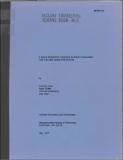| dc.contributor.author | Chen, Franklin Fun Kun | en_US |
| dc.contributor.author | Griffith, P. (Peter) | en_US |
| dc.contributor.author | McManamy, Thomas Joseph | en_US |
| dc.contributor.author | Was, Gary S. (Gary Steven), 1953- | en_US |
| dc.contributor.other | Massachusetts Institute of Technology. Department of Nuclear Engineering. Fusion Technology Program | en_US |
| dc.contributor.other | Massachusetts Institute of Technology. Department of Nuclear Engineering | en_US |
| dc.date.accessioned | 2014-09-12T23:53:53Z | |
| dc.date.available | 2014-09-12T23:53:53Z | |
| dc.date.issued | 1977 | en_US |
| dc.identifier.uri | http://hdl.handle.net/1721.1/89511 | |
| dc.description | Statement of responsibility on title-page reads: Franklin Chen, Peter Griffith, Thomas McManamy, and Gary Was | en_US |
| dc.description | "May 1977." | en_US |
| dc.description | "This study is basically an integration and extension of a doctor's thesis by Franklin Chen and a master's thesis by Gary Was." | en_US |
| dc.description | Includes bibliographical references (leaves 244-248) | en_US |
| dc.description.abstract | The objective of this study was to evaluate a new concept for a Tokamak type fusion reactor blanket. The design was based on using a packed bed of lithium aluminate as the breeding material with helium gas cooling. The unique aspect of the design was the assumption that small coolant leaks were inevitable and should not necessitate major maintenance. A modularized design was chosen with cylindrical breeder rods and graphite shim rods. Redundancy was provided by designing the blanket such that if a module failed it could be depressurized and its heat load shared by the neighboring operating modules. The thermal hydraulic analysis evolved analytical and computational methods for determining the temperature profiles of all components and the pumping power requirements. A computer program TRIPORT was developed to evaluate the tritium retention and transport. A one dimensional ANISN code was used to determine the breeding ratio for different configurations.!
The thermal hydraulic, neutronic and mechanical aspects of the Breeder Rod Shim Rod (BRSR) design were combined to determine a design window, that is the allowable range of system parameters. Unfortunately adequate breeding could not be demonstrated so that there was no open window. Basically the low breeding was caused by -he inherently poor breeding potential of LiAlO, combined with the additional structure required for failure mode operation. However, this conclusion is based on a specific design concept (BRSR) and further research in the area may prove more fruitful. | en_US |
| dc.format.extent | xxiii, 248 leaves | en_US |
| dc.publisher | Cambridge, Mass. : Fusion Technology Program, Massachusetts Institute of Technology, 1977 | en_US |
| dc.relation.ispartofseries | MITNE ; no. 213 | en_US |
| dc.subject.lcc | TK9008.M41 N96 no.213 | en_US |
| dc.subject.lcsh | Tokamaks | en_US |
| dc.subject.lcsh | Fusion reactors | en_US |
| dc.subject.lcsh | Breeder reactors | en_US |
| dc.subject.lcsh | Nuclear fuel elements | en_US |
| dc.title | A Solid breeder tokamak blanket designed for failure mode operation | en_US |
| dc.type | Technical Report | en_US |
| dc.identifier.oclc | 04536019 | en_US |
